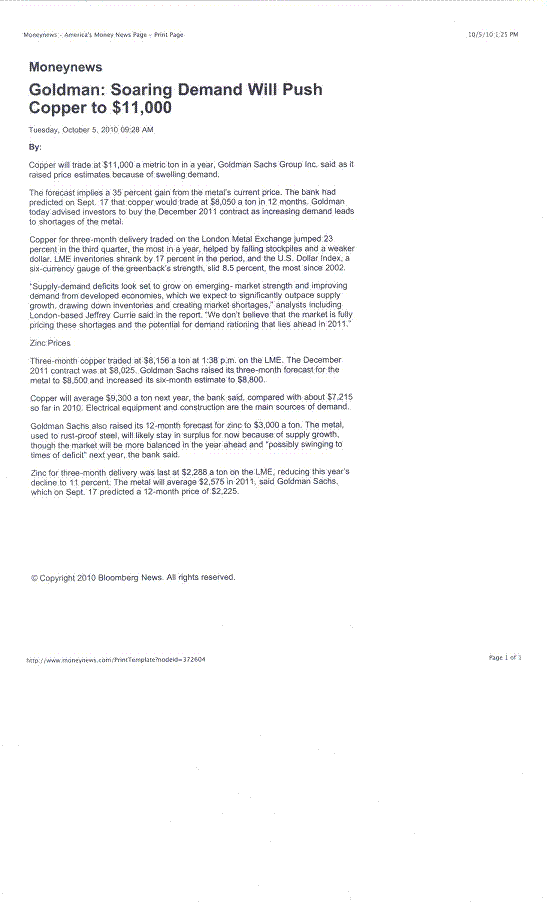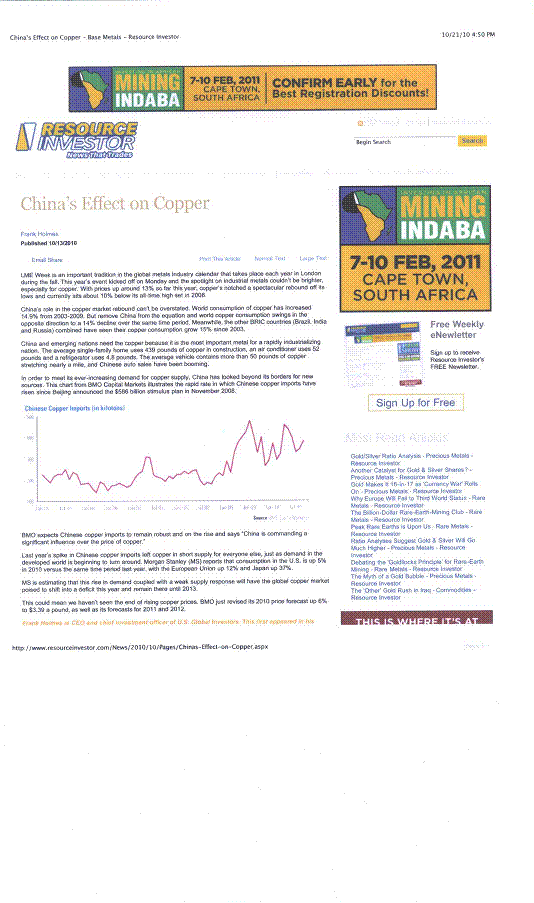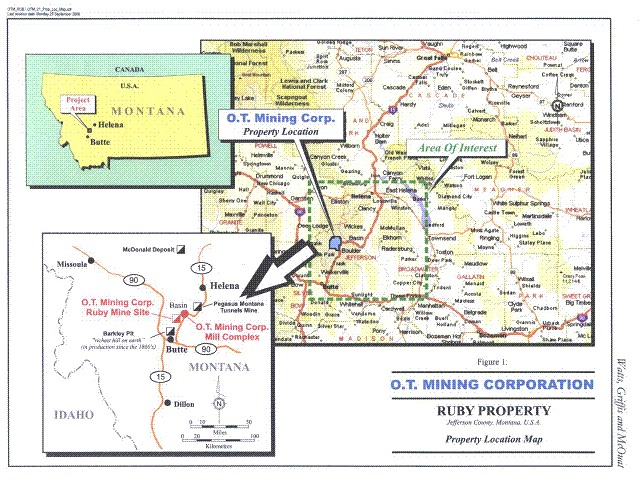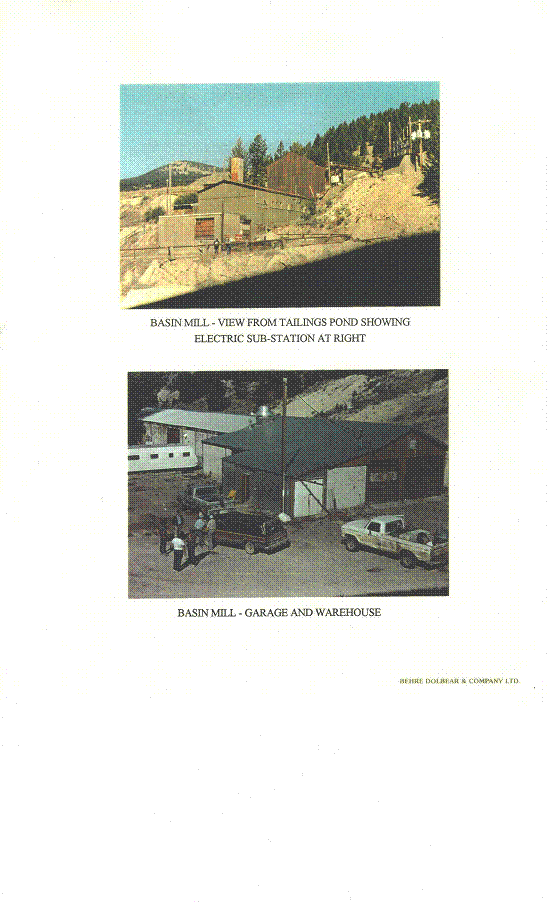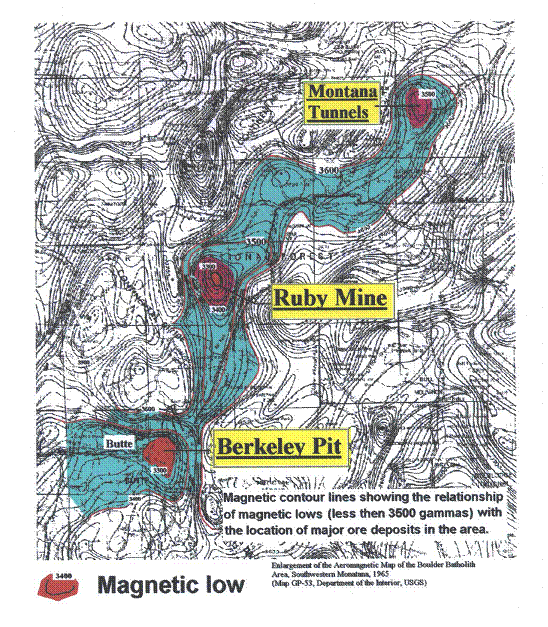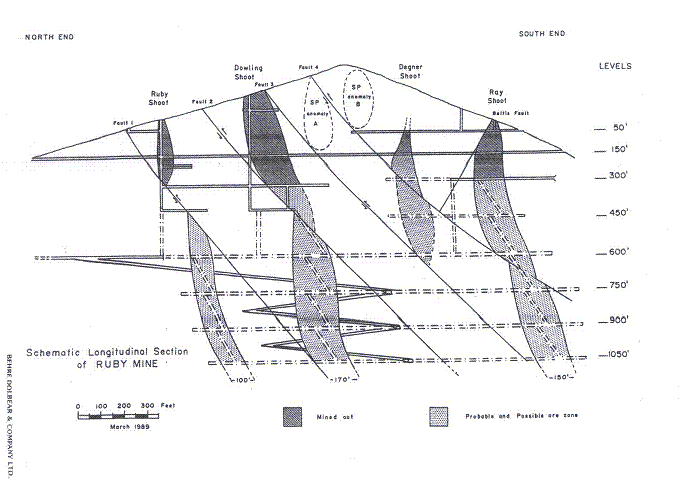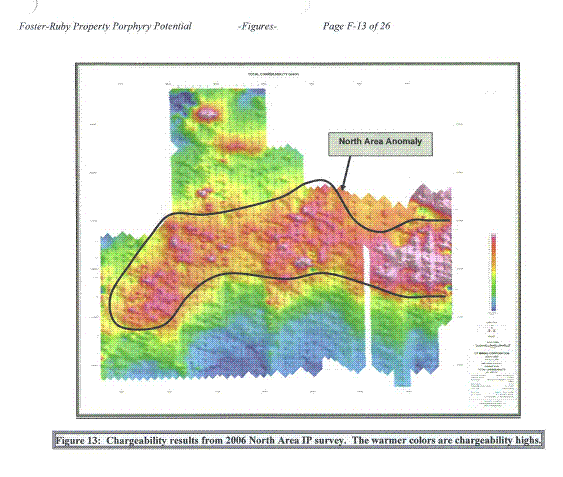 |
 |
|
The O.T. Mining Corporation Investment is defined as “putting money into something with the hope of a profit,” especially in a market opportunity where the demand for a product or service is stronger than available supply. Such is the case today as far as the rising world market demand for copper and other base metals is concerned, and finding new inventories to exploit particularly in North America, given the unlikelihood of hostile government takeovers is the goal and priority for many of the major mining companies. Investing in junior mining companies with interest in properties on American soil makes more sense, since any successful exploration company can very well become a prime candidate for a buy out, on a fairly large scale, by one of the majors. (See articles on demand for copper appendix - 1) Many of the great mining camps of America are either scratching the bottom of the barrel or bear mute testimony to the fact that those reserves once thought to be unlimited, no longer can provide for the demands of our society, and throughout the world. Listed among the great mining camps of the United States, now long silent, are those of Calumet and Hecla and the iron mines in Michigan. Among those historic providers, is the great mining camp of Butte, Montana, once known as the “Richest Hill on Earth”. The Butte deposit has provided a very significant portion, not only of copper, but many other metals, and presently continues to offer supply to a fraction of world demand. Lying about 14 miles to the north-northeast of Butte is an old gold and silver mining camp known as the Ruby Mine. Exploration to date on this 21.3 square mile property, controlled by The O.T. Mining Corporation, a junior mining exploration company, has provided evidence to support the theory that another Butte style ore deposit may in fact exist. (See location map appendix – 2) Evidence gleaned through the application of modern cutting edge exploration technology gives credence to the possibility that a copper ore resource as large as or greater than the Butte mining camp may well be hiding in the vicinity of the Ruby. Given the thirst of the major mining companies actively seeking new copper inventories on American soil, an investment in the Ruby property constitutes a rare opportunity for extraordinary profitable returns. Company Profile The O.T. Mining Corporation (“O.T.”) is a U.S. junior exploration company whose assets consist of 100% ownership (less a 3% net smelter royalty) of the 21.3 square mile Ruby Property and the nearby Basin Mill in Jefferson County, southwestern Montana as well as a 16.93% ownership interest in Namex Explorations Inc., a Canadian junior exploration company that is presently being restructured. (See photos of Basin Mill and office/core storage facility appendix – 3) O.T. was incorporated in the State of Montana in 1980 as Ruby Resources of Montana Inc. On May 4th, 1987, the Company’s name was changed to The O.T. Mining Corporation. O.T’s stock trades on the Pink Sheets www.pinksheets.com – symbol OTMN.PK. O.T. is a United States non-designated 15c 2-11 company. The Cusip number is 671061 109. O.T. is listed in Standard and Poor’s and Mergent Inc.’s OTC Industrials. As at February 28, 2011, O.T. had 15,713,693 common shares issued and 1,451,157 options outstanding. Fully diluted – 17,164850. (See fact sheet for additional information appendix - 4) Property Description and Location The Ruby Property is one of the few enormous exploration projects in the free world. It covers 21.3 contiguous square miles and consists of 13 patented and 681 unpatented claims in Jefferson County, Montana. It is host to precious - gold and silver - and multiple base metals - copper, lead, zinc, cobalt and molybdenum. The northern 14.5 square miles of the Property contains a large copper/molybdenum porphyry system and the southern 6.8 square miles hosts a high-grade gold, silver and base metals epithermal volcanic system. The project has now reached the definitive drilling stage. Forty-five drill holes and access roads have been permitted and the technical team is ready and eager to get to work. The Ruby Property lies between two major mines and shares many geological features including the same geological formation (the Boulder Batholith) with them. One is the world famous Butte mine, the Continental Copper Mine (known as the Berkeley Pit when owned by The Anaconda Copper Company). Berkeley/Continental, which is 14 miles south west of the Ruby Property, is approaching $50 billion of high-grade base and precious metals production since the 1860’s with estimates of a similar amount yet to be discovered. The other mine is the Montana Tunnels Mine, 20 miles northeast of Ruby. It was a major producer from the 1860’s through the early 1930’s, and was brought back into production in 1988. Since then, this open pit mine has produced more than 50 million tons of gold, silver, lead and zinc ore. (See the magnetic low the O.T. shares with Butte and Montana Tunnels appendix - 5) Historical Exploration of the Ruby Property The Ruby Mine was a low tonnage, high-grade producer of gold and silver between 1885 and 1912. Knopf (1913), Corry (1920) and Earl (1980) estimated that 42,184 ounces of gold at 2.44 ounces per ton and 446,565 ounces of silver at a grade of 38.66 ounces per ton were produced. The operators mined ore from the surface to a depth of 300 feet. Shaft mining of the “bonanza ore shoots” - The Ruby, Dowling, Degner and Ray - ceased in 1912 due to the technology of the day being unable to deal with water problems below the 300 foot level. (See graph of bonanza gold and silver ore shoots appendix - 6) In 1914, the last miner began a horizontal adit at the 600 foot level to intersect the ore shoots. This effort ceased in 1917 when the operator ran out of money. Work resumed in 1966 when the adit was driven to nearly 3,100 feet. While missing the target by just 200 feet, a lead-zinc zone was intersected. A 193 ton bulk sample was taken, which returned 1.33 percent copper, 5.19 percent zinc, 7.6 percent lead and 4.3 ounces of silver per ton. In 1976, a major mining company conducted a geologic and economic study that indicated that as much as 600,000 tons of gold and silver ore remained in the proven and unproven bonanza ore shoots. The company further concluded that the Ruby could host a potential porphyry copper mine - large enough to justify a 20,000 - ton per day mill. In 1980, this company entered into a joint venture agreement with O.T.’s predecessor, Ruby Resources Ltd. When the former failed to fulfill its obligations because of cash flow problems, Ruby Resources recovered its full title. A technical report, prepared by the respected consulting firm of Behre Dolbear & Company Ltd. dated April 11, 1997, estimates the Ruby Mine “to have superior exploration potential. As an established gold and silver property, Ruby has identified gold and silver exploration targets. A base metals vein was encountered on the property when exploration operations renewed briefly in the mid - 1960’s. This vein is an exploration target. Finally, evidence suggests the presence of a large intrusive body at depth, which comprises a porphyry copper target. The property presents diverse exploration targets, comprising gold and base metal potential”. Exploration Work on The Ruby by O.T. In 1987 with O.T. as owner, the Property consisted of the immediate Ruby Mine area that covered 479 acres. O.T.’s focus was on exploring and developing the Ruby Mine into a small tonnage high-grade producer of gold and silver. However, extensive research and exploration work led to the understanding of the similarities between the Ruby Property and the Butte Mining Camp. This in turn led to the quiet acquisition of additional claims. At present, O.T.’s mineral claims cover 21.3 square miles. Systematic exploration work has been carried out over the Property and included an airborne DIGHEM and magnetic survey in 2001 by Fugro, a Titan 24 MT-IP survey by Quantec Geoscience Ltd. in 2004, IP surveys by Matrix Geo Technologies in 2005 and 2006, extensive Mobile Metal Ion (“M.M.I.”) geochemical surveys, limited drilling, geologic mapping, surface sampling and prospecting. All of the old exploration data has been compiled and examined in detail and the geology of the Butte porphyry system has been studied and used to help understand the Ruby Property. (MMI defined appendix – 7) Six exploration target areas have been identified in order of exploration priority they are
In addition, the existing April Vein and Ruby West Targets have potential for Ruby mine-type mineralization, and the West Target has potential for porphyry-type mineralization. The results from the cumulative programs and the opinions and conclusions drawn by O.T.’s technical team have been verified and are fully supported by the internationally respected mineral consulting firm of Watts, Griffis & McOuat, www.wgm.on.ca in its Technical and Recommendations Report dated November 27, 2006. The Report, prepared in compliance with National Instrument 43-101 confirms O.T.’s findings and recommends a diamond drill program on O.T.’s four elephantine targets. O.T.’s present exploration program will begin by concentrating its efforts on the superior economic porphyry system that is geologically similar to the porphyry system at Butte. Work completed since 2004 has documented the presence of a North Area Target that is at least 15,000 feet long by 8,000 feet wide and at least 2,600 feet thick. It is open in two directions and at depth. In 2008, with the input from several porphyry experts, the “Dry Gulch Target”, located to the south of the North Area Target, became another priority porphyry target. It has a similar size and shape as the North Area Target and has similar potential. (See definition of a porphyry appendix – 9) Dr. Fess Foster released a comprehensive report, dated August 11, 2009, that is posted on O.T.’s web site; www.otmining.com. It favorably compares the Ruby porphyry system with the porphyry system at Butte. Production from the Butte Camp is approaching $50 billion in metals since the 1860’s. Approximately 95% of this wealth was mined from “Main Stage Veins” and the Ruby Project has the potential for similar veins. As Dr. Foster says, “the most compelling justification for exploring the Ruby Porphyry is its striking similarity with the porphyry system at nearby Butte”. The Porphyry The Ruby Porphyry appears to be a very large system based upon the very limited drilling and geophysical data available. There seems to be about 16 billion tons of potassic and phyllically altered porphyry with continuous low level copper enrichment in the North Area Target. The Dry Gulch dimensions are unclear but could be the same as the North Area Target. If so, the total size of potassic and phyllically altered porphyry with low level copper enrichment could be as much as 32 billion tons, and is open to the east, west and at depth. The Ruby porphyry appears to be a Type 2 system. Type 2 porphyries contain hydrolytic alteration that postdates and extends down into core potassic alteration. Many of the world’s great porphyry ore bodies have late stage veins associated with this hydrolic alteration. These include Butte MT., Resolution AZ., Chiquicamata, Escondida, Rosario and El Salvador; the latter four deposits occur in Chile. The late veins can contain substantial underground mineable ore, and host a considerable amount of the overall metal content of the porphyry system. Over 95% of the metal production from Butte was from the late (Main Stage) veins. Butte and Ruby are metallogenetic twins. The following are some of the important geological similarities between the Butte and Ruby porphyry systems:
O.T.’s exploration plan for the Ruby focuses on underground targets similar to the spectacular Main Stage mineralization at Butte. Production records were not kept in the early days, but production from Butte is known to have been significant. Recorded production from the Butte District totals approximately:
Underground ore was mined at Butte from the four types of veins described below. Gold is not listed because it is a byproduct and occurs in very low concentrations. Molybdenum is not listed because it was never mined from underground.
Butte type veins would be extremely profitable in today’s market. Copper appears to be the most dominant metal at Ruby. Assuming that veins are discovered with the same average grade as the above-discussed copper veins (ie. 4.4% copper and 2.7 ounces of silver per ton), they would have a net value of U.S. $400 per ton at today’s metal prices. Current underground mining costs for high-grade veins are in the $100 - $230 per ton range. Mining costs for Butte type veins would likely be in the low end of this range. These costs do not include exploration, permitting, development etc. expenditures, but the profitability of mining Butte-type veins with current metal prices is apparent. The very limited drilling to date at Ruby indicates the following: Copper is the most common and dominant metal encountered. It is anticipated that copper would be an important component of any Butte-type veins that may be discovered. Molybdenum, silver and gold are widespread. Lead and zinc are uncommon but have been encountered in a few narrow veins. Therefore, these five metals may also be present in yet to be discovered veins. No significant manganese has been identified to date but could be encountered with additional drilling. The Exploration Program As with all exploration, it is not possible to determine in advance the exact amount of exploration work that will be required and where it will be done. Dr. Fess Foster’s budget of $16,140,000 for pure exploration work is a very reasonable estimate. Significant additional funds should not be required, and the work may not be as costly as estimated. As new geophysical, geochemical, geological and drilling information becomes available, they will be carefully analyzed and appropriate changes made to the program. The most successful exploration programs are those that allow the geologists to modify the plan accordingly as more data becomes available and the rocks are better understood. (See Dr. Fess Foster’s exploration budget appendix – 10) The program will begin by drill proving the North Area target. Surface geophysics and geochemistry have been completed, and it is now ready to drill. The Dry Gulch Area requires additional geophysical and geochemical studies before the optimal drill hole locations can be determined. Funds have been included for geophysical, geochemical and geological (mapping and surface sampling) studies of the area north of the Boulder River. Very little work has been done here, and the porphyry system could extend beneath this area. This is a substantial program due to the large size of the Ruby Porphyry. The program is budgeted over a three-year period. It may be possible to complete most of the work in two years. The program should not be rushed. Exploration odds are greatly improved with a methodical, scientific approach. Significant Investment Opportunity
In the words of James Hess, the late founder of O.T, as he pondered the Ruby Project; “I would never try and second guess Mother Nature. Why would she set all the precise conditions up for another Butte like deposit and not deliver the goods? I am convinced the ore is there. We just have to find the main stage veins”. When the drill bit bites into the ground and the final lie detector test is carried out, the truth shall be known and it is our hope that the dream of James Hess and all those who have been captivated by the Ruby will be redeemed. O.T. is seeking 20 million dollars to fund the exploration and drilling program and to provide working capital. Rosemary L. Christensen
Disclaimer: This Executive Summary contains forward-looking statements regarding the Company, within the meaning of Section 27A of the Securities Act and Section 21E of the Exchange Act, including statements regarding the anticipated timing, process and scope of further exploration and drilling activities. These statements are based on assumptions that the Company believes are reasonable but that are subject to uncertainties and business risks.
Corporate Information Sheet General
Name of Company: The O.T. Mining Corporation Mailing Address: 310 Victoria Avenue, Suite 103, Westmount, Quebec H3Z 2M9 Canada Telephone Number: 514-935-2445 Fax Number: 514-935-8161 Web Page: www.otmining.com Contact: Rosemary L. Christensen, President Email: rchristensen@otmining.com or info@otmining.com Related Companies: Working Interest Corporation – wholly owned subsidiary that holds the shares of Namex Explorations Inc.
Corporate and Professional Services
Montana CPA: Bill Holmlund Corporate Accountant: Stephen Cleaver, Chartered Accountant Legal Counsel: Howard M. Sommers, Esq. Montana Counsel: William L. MacBride, Jr. Advisor: Joe Hinzer, President Corporate Services: Continental Stock Transfer & Trust Company
Innovative Technology: Mobile Metal Ions Process Soil geochemical exploration has been a routine part of mineral exploration for 75 years. The application of traditional single or multiple acid digests of soil samples has been the backbone of many programs worldwide for both major and junior mining explorationists. In conjunction with geological mapping and geophysical surveys, these traditional approaches have been successful in delineating or outlining near-surface ore bodies. However the mining industry recognized that additional deposits of high-grade base and precious metals are present beneath those discovered at surface. It became apparent that a geochemical tool was required that would permit explorationists to "see" beneath the surface and identify these high-grade ore bodies. Acting on a request from the Australian mineral exploration industry, Dr. Alan Mann and colleagues at the Mineral Exploration Research Institute of Western Australia developed a radically different approach to soil geochemical exploration. Their technique, known as the Mobile Metal Ions Process ("MMI"), focuses on the extraction of metals from a fixed location in the soil profile based on a proprietary dissolution or digestion of soil samples. In addition, ligands or chemical compounds specific to base and precious metals are used in the process to keep metal ions in solution subsequent to extraction from the soils. This prevents the metals from precipitating out of solution or becoming stuck to the vessels used during the digestion, analysis, process and permits an accurate measurement of the amount of metal in the soil. The metal ions measured with the MMI process have migrated upwards from a buried mineral source and become attached to individual soil particles or grains. Their mode of transportation from buried source to surface is considered to be primarily by ground water and subsequent evaporation, however, a variety of methods probably assist in mobilizing ions to surface and include evapotranspiration, self-potential "battery effect", the vertical component of ground water flow, vapour phase transport and simple diffusion. The recognition of an MMI soil geochemical anomaly not only has significant implications for focused exploration at depth but also for reducing costs during an exploration program. The MMI anomalies have been documented in over 1000 case history studies worldwide to form directly above their source. This permits focused drill testing and avoids the traditional "shot-gun" approach that results in significantly increased costs from inaccurately sited drill collars. The source or mineralized zone producing the MMI anomaly has been drill proven to depths of 2000 feet. The O.T. Mining Corporation ("OT") has delineated a porphyry copper-molybdenum deposit at this depth in Montana during their MMI-assisted exploration of the Ruby property. The success of the MMI approach on the Ruby property has been such that in the future, airborne and ground geophysics and geological mapping may be avoided with target delineation based solely on MMI soil geochemistry. This represents a further reduction of exploration costs that can be redirected into focused drill testing. The MMI technique is capable of detecting very subtle geochemical signatures generated by buried mineralized zones but it will neither indicate the grade of these mineralized zones nor the depth at which they occur. Drilling must be done to confirm depth and grade. Generally speaking, however, the larger and higher the MMI signal the greater the size of the mineralized zone. Ground geophysical techniques such as ionization potential (I.P.) can be utilized to define the depth to mineralization. The tools necessary for the use of MMI geochemistry are simple and inexpensive. These include a shovel, vinyl scoop, ruler and snap-shut plastic sample bags. Samples are not sieved and no further preparation in the field or laboratory is undertaken or required. A two-man crew or a single sampler can easily collect the appropriate samples from the area of interest. Samples can be collected from a grid or over individual geologic features (faults, shear zones, unique rock types) or over geophysical anomalies (magnetic, electro-magnetic) to prioritize drill testing by determining which of these features contains the most significant metal source. The MMI survey will indicate whether the target is a base or precious metal-rich target. The MMI approach has been responsible for numerous technical and commercial successes worldwide. Some of these are listed on the MMI website at www.mmigeochem.com.
**************
Definition of Porphyry Copper
Porphyry copper: a deposit of disseminated copper minerals in and around a large body of intrusive rock which also contains gold, molybdenum, tungsten and other metals. These ore bodies traditionally contain hundreds of millions to multibillion tons of ore. Properly mineralized porphyries become the largest and richest mines in the world. Porphyry copper deposits form when certain types of molten magmas cool beneath the earth’s surface. Hot waters carrying metals accumulate in the top of the magma bodies. The metals can be speckled (or “disseminated”) throughout the rock, or be deposited in cracks (as “veins” of “veinlets”). Common metallic minerals include pyrite (iron sulfide), chalcopyrite (copper sulfide), and molybdenite (molybdenum sulfide). Collectively, the presence of these metallic minerals is called “mineralization”. The hot water that carries the metals bleaches and changes the surrounding rocks by forming clays and other new minerals. This is called “alteration”, and is analogous to exposing colored clothes to hot water for an extended period, causing them to become bleached. Porphyry copper deposits form distinctive types of alteration, including “potassic” and “phyllic” alteration. These alteration zones can occur much like the peels of an onion, with the ore zone near the center, similar to a bullseye. Understanding the type and shape of alteration areas in the porphyry system is obviously very important.
Budget
MANAGEMENT, DIRECTORS AND TECHNICAL TEAM
Obviously, management and the technical team are the key to O.T.’s or any exploration company’s success. To this end, O.T. has assembled a team of proven “mine makers” with over 150 years of combined experience in the field. In addition, the company only utilizes the services of the highest caliber independent contractors; those used and recognized by the major mining companies. Rosemary L. Christensen, President, Secretary-Treasurer and Director As a co-founder of O.T. with the late James W. Hess, whose vision and drive resulted in the present company, Rosemary Christensen became Secretary Treasurer and a Director in 1987. She became President in July of 2009. Christensen, a member of the Quebec Bar, founded the Somerville House Companies that have been involved in the investment business since 1972. She pioneered motion picture syndication in Canada, created tax incentive investments and expanded the company to include the metals mining industry. J.R.O. Walli, P. Eng., Vice President and Director J.R.O.Walli is a member of the Canadian Institute of Mining and Metallurgy and a member of the Association of Professional Engineers. Amongst Mr. Walli’s more notable achievements: From 1962 to 1967 when with Associated Mining Construction Ltd., he was responsible for the design and construction of seven deep potash shafts sunk by the freezing process, a technology that he brought to Canada from Germany. From 1967 to 1969, Mr. Walli was Project Manager, Minera Andina S.A., Santiago, Chile, more popularly known as the Rio Blanco Project of Cerro Corporation, New York. He was responsible for design, procurement and construction of this 10,000 metric ton per day underground copper mine located in the high Andes, incorporating a number of “world firsts” for the mining industry; eg. the concentrator was constructed underground in huge caverns excavated for the purpose of locating it away from the hostile avalanche environment. In 1975 Mr. Walli became Managing Director at the inception of the Oman Mining Company, L.L.C.., Muscat, Sultanate of Oman. His team brought on-line three underground copper mines, a 3,000 tonne per day concentrator, a 20,000 tonne per year electric smelter, a 24,000 tonne per year electric refinery and a 54 megawatt gas turbine power plant. The design and construction of a deep water jetty was implemented for this totally self contained fully integrated facility Fess Foster, B.Sc., Ph.D., C.P.G, Senior Geologist, Montana Dr. Foster has 27 years of primarily industry experience. His background includes exploration geology, mine permitting, environmental evaluations, project management and public/government affairs. Formerly he was Director of Geology and Environmental Affairs at the 3 million ounce-plus Golden Sunlight Mine near O.T.'s Ruby Property and later VP of Exploration for American Bonanza Gold Mining Corp. At Golden Sunlight Mine, Dr. Foster instituted a strong exploration program that resulted in the delineation of 1.1 million ounces of gold reserves at a cost of $4. per ounce and was personally responsible for the discovery of a 330,000 ounce gold deposit. He also initiated a progressive environmental program and has extensive experience with Montana permitting and regulatory issues. Mark Fedikow, HBSc., M.Sc., Ph.D., P.Eng., P.Geo., C.P.G , Director and Vice President of Exploration, 2003 Dr. Fedikow has 30 years of industry and government experience as an exploration geochemist and mineral deposits geologist. In 2001 he was the recipient of the Provincial Geologists Medal, a Canadian national award for outstanding geoscientific achievement. As an exploration geochemist and mineral deposit geologist, he has published numerous articles on mineral deposits and their geochemical expressions in rock, soil and vegetation sample media. Specifically, he has applied the Mobile Metal Ions Process (MMI) in exploration programs for lode gold, base metal massive suphides, platinum group metals, magmatic nickel-copper, epithermal gold-silver and porphyry copper deposits in a variety of geological and overburden environments. Mark is a Fellow of the Association of Applied Geochemists. Oliver T. Maki, Chief Geologist Mr. Maki began his career in 1945 working in Latin and North America in all facets of the mining industry for such companies as Gulf Sulphur where he was responsible for its Mexican sulphur operations, as general superintendent for the American Zinc Company in the U.S., as an economic geologist for the United Nations Development Program in Chile and as an economic geologist for the Organization of American States, Washington, D.C. Mr. Maki, in 1969-70, directed and carried out the exploration program on which his third drill hole was the discovery hole for one of the largest open pit copper mines in the world, the three billion ton Los Pelambres copper mine on the border of Chile and Argentina. Thomas H. Fitzgerald, Jr. Director since 1987 In 1959, Mr. Fitzgerald founded and is President and Senior Investment Officer of the firm that bears his name. For 18 years he was editor of the Money Market Directory. He is a member of the American Finance Association and the Presidents Council of the American Institute of Management and the Market Technicians Association. Mr. Fitzgerald served in Korea as a paratroop lieutenant with the United States Army. Arthur Seligman, Director since 1991 Since 1984, Mr. Seligman has been Director of Sales and Marketing for the Petroleum Development Company (PDC). During his tenure, the company has grown to become the largest distributor of public hydrocarbon drilling programs in the country. Its Investor Relations Department, which he established, receives annual praise from the broker/dealer community as the best in the business.
Disclaimer:This shareholder letter contains forward-looking statements regarding the Company, within the meaning of Section 27A of the Securities Act and Section 21E of the Exchange Act, including statements regarding the anticipated timing, process and scope of further exploration and drilling activities. These statements are based on assumptions that the Company believes are reasonable but that are subject to uncertainties and business risks. Actual results relating to any and all of these subjects may differ materially from those presented. Factors that could cause results to differ materially include economic and political events affecting supply of and demand for base and precious metals, fluctuations in commodity prices, negative results of environmental or technical studies, negative results of further exploration, drilling programs, problems or delays in or objections to the permitting process, failure or delay of third parties to provide services, changes in the attitude of state and local officials toward the Ruby Project and other factors. Additional information is available at the Company’s website at www.otmining.com. |
||||||||||||||||||||||||||||||||||||||||||||||||||||||||||||


